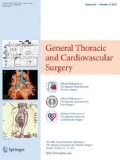Abstract
Objectives
Pulmonary hypertension during cardiac surgery is associated with increased morbidity and mortality. Inhaled nitric oxide serves as a selective pulmonary vasodilator and has other potential extrapulmonary protective roles. Its effects on pulmonary hypertension and organ functions after adult valve surgeries were evaluated.
Methods
From April 2017 to March 2000, 30 patients received inhaled nitric oxide therapy for pulmonary hypertension during weaning from cardiopulmonary bypass in valvular surgery (iNO group). The group was compared with a control group of 65 patients who developed pulmonary hypertension during weaning from cardiopulmonary bypass in valvular surgery and received conventional therapy from April 2014 to March 2017. Intraoperative hemodynamic changes and postoperative Sequential Organ Failure Assessment (SOFA) score were evaluated.
Results
The inhalation of nitric oxide lowered the pulmonary-to-systemic pressure ratio (Pp/Ps) (p < 0.0001) in the iNO group, and this ratio after the inhalation was significantly lower than that in the control group (p = 0.015). Moreover, norepinephrine requirement was lower in the iNO group than in the control group (p = 0.0060). The SOFA total scores, respiratory scores, coagulation scores, and the increase of renal scores within postoperative 2 days were lower in the iNO group than in the control group (p < 0.0001, p = 0.0002, p = 0.0013, and p = 0.037).
Conclusions
Inhaled nitric oxide therapy ameliorated pulmonary hypertension and improved postoperative respiratory, coagulation, and renal functions in adult valve surgeries.


Similar content being viewed by others
References
Denault A, Deschamps A, Tardif J-C, Lambert T, Perrault L. Pulmonary hypertension in cardiac surgery. Curr Cardiol Rev. 2010;6:1–14. https://doi.org/10.1007/978-3-319-60804-4_3.
Pepke-Zaba J, Higenbottam TW, Dinh-Xuan AT, Stone D, Wallwork J. Inhaled nitric oxide as a cause of selective pulmonary vasodilatation in pulmonary hypertension. Lancet. 1991;338:1173–4. https://doi.org/10.1016/0140-6736(91)92033-X.
Griffiths MJD, Evans TW. Inhaled nitric oxide therapy in adults. N Engl J Med. 2005;353:2683–95. https://doi.org/10.1056/NEJMra051884.
Ichinose F, Roberts JD, Zapol WM. Inhaled nitric oxide: a selective pulmonary vasodilator: current uses and therapeutic potential. Circulation. 2004;109:3106–11. https://doi.org/10.1161/01.CIR.0000134595.80170.62.
McMahon TJ, Doctor A. Extrapulmonary effects of inhaled nitric oxide: role of reversible S-nitrosylation of erythrocytic hemoglobin. Proc Am Thorac Soc. 2006;3:153–60. https://doi.org/10.1513/pats.200507-066BG.
Spina S, Lei C, Pinciroli R, Berra L. Hemolysis and kidney injury in cardiac surgery: the protective role of nitric oxide therapy. Semin Nephrol. 2019;39:484–95. https://doi.org/10.1016/j.semnephrol.2019.06.008.
Vincent J-L, Moreno R, Takala J, Willatts S, de Mendonca A, Bruining H, et al. The SOFA (Sepsis-related Organ Failure Assessment) score to describe organ dysfunction/failure. On behalf of the Working Group on Sepsis-Related Problems of the European Society of Intensive Care Medicine. Intensive Care Med. 1996;22:707–10. https://doi.org/10.1007/BF01709751.
Vincent J-L, de Mendonca A, Cantraine F, Moreno R, Takala J, Suter PM, et al. Use of the SOFA score to assess the incidence of organ dysfunction/failure in intensive care units: results of a multicenter, prospective study. Working group on “sepsis-related problems” of the European Society of Intensive Care Medicine. Crit Care Med. 1998;26:1793–800. https://doi.org/10.1007/BF01709751.
Ferreira FL, Bota DP, Bross A, Melot C, Vincent J-L. Serial evaluation of the SOFA score to predict outcome in critically ill patients. J Am Med Assoc. 2001;286:1754–8.
Umehara N, Saito S, Tsukui H, Yamazaki K. Usefulness of JapanSCORE-comparative study of the usefulness of the JapanSCORE and the logistic EuroSCORE. Jpn J Cardiovasc Surg. 2013;42:94–102.
Loh E, Stamler JS, Hare JM, Loscalzo J, Colucci WS. Cardiovascular effects of inhaled nitric oxide in patients with left ventricular dysfunction. Circulation. 1994;90:2780–5. https://doi.org/10.1161/01.cir.90.6.2780.
Hagberg IA, Solvik UO, Opdahl H, Roald HE, Hagberg IA, Sølvik UØ, et al. Inhalation of nitric oxide inhibits ADP-induced platelet aggregation and alpha-granule release. Platelets. 1999;10:382–90. https://doi.org/10.1080/09537109975852.
Keh D, Gerlach M, Korea I, Falke KJ, Gerlach H, Clinic V. Reduction of platelet trapping in membrane oxygenators by transmembraneous application of gaseous nitric oxide. Int J Artif Organs. 1996;19:291–3.
Wang J, Cong X, Miao M, Yang Y, Zhang J. Inhaled nitric oxide and acute kidney injury risk: a meta-analysis of randomized controlled trials. Ren Fail. 2021;43:281–90. https://doi.org/10.1080/0886022X.2021.1873805.
Lei C, Berra L, Rezoagli E, Yu B, Dong H, Yu S, et al. Nitric oxide decreases acute kidney injury and stage 3 chronic kidney disease after cardiac surgery. Am J Respir Crit Care Med. 2018;198:1279–87. https://doi.org/10.1164/rccm.201710-2150OC.
Author information
Authors and Affiliations
Corresponding author
Ethics declarations
Conflict of interest
All authors declare that there is no conflict of interest.
Additional information
Publisher's Note
Springer Nature remains neutral with regard to jurisdictional claims in published maps and institutional affiliations.
Supplementary Information
Below is the link to the electronic supplementary material.
Rights and permissions
About this article
Cite this article
Nakane, T., Esaki, J., Ueda, R. et al. Inhaled nitric oxide improves pulmonary hypertension and organ functions after adult heart valve surgeries. Gen Thorac Cardiovasc Surg 69, 1519–1526 (2021). https://doi.org/10.1007/s11748-021-01651-z
Received:
Accepted:
Published:
Issue Date:
DOI: https://doi.org/10.1007/s11748-021-01651-z




